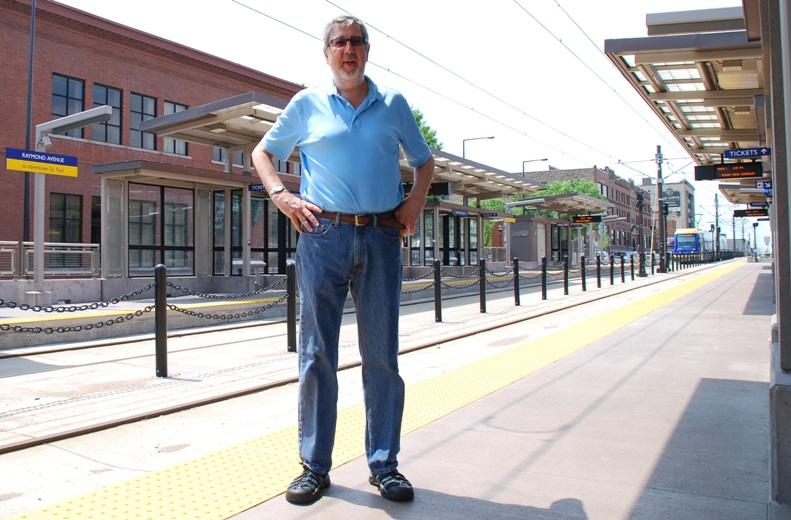 Aaron Isaacs worked at Metro Transit from 1973 to 2006. A historian with the Minnesota Streetcar Museum, Isaacs is the co-author of Twin Cities by Trolley and author of Twin Ports by Trolley, which will be released in September. Isaacs also edits Twin City Lines, a quarterly magazine about Twin Cities transit history.
Aaron Isaacs worked at Metro Transit from 1973 to 2006. A historian with the Minnesota Streetcar Museum, Isaacs is the co-author of Twin Cities by Trolley and author of Twin Ports by Trolley, which will be released in September. Isaacs also edits Twin City Lines, a quarterly magazine about Twin Cities transit history.
For 63 years, streetcars rolled down University Avenue connecting Minneapolis and St. Paul. When the METRO Green Line opens this weekend, 60 years after the last streetcar made its way through the corridor, the Twin Cities' premier transit corridor will once again have the rail transit it deserves.
The history of rail service in the University Avenue corridor is long and rich.
In the 1880s, special railroad passenger trains operated by Great Northern, Milwaukee Road and Minneapolis & St. Louis ran every hour between the cities, stopping at stations every mile or so. Several of these stations were linked to residential areas such as Merriam Park, Macalester Park, Desnoyer Park, St. Anthony Park and Prospect Park. These neighborhoods featured curving streets, hills and parks designed to offer the latest in suburban living, despite being inside the city limits.
At the time, street railroads were in their infancy. Horse cars provided trips from the downtowns, but managed just five miles per hour and traveled only as far as Dale Street in St. Paul and Seven Corners in Minneapolis.
All that changed when electric streetcars became commercially viable in 1888. Although they were two separate corporations, the St. Paul City Railway and the Minneapolis Street Railway were both owned by a group headed by Thomas Lowry. Both companies immediately began converting horse cars to electricity.
Connecting Minneapolis and St. Paul was a high priority and was accomplished in December 1890. The new line was dubbed The Interurban and followed the same basic route as the new Green Line, differing only in the downtown areas.
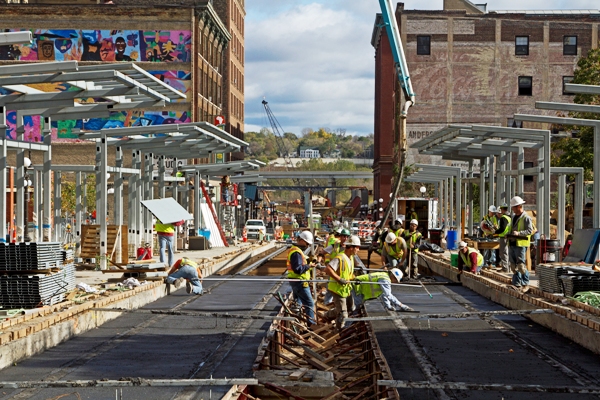 It took just three years for the electric streetcars to put the competing short line railroad trains out of business. The streetcars were more frequent, charged a lower fare, stopped closer to where people wanted to go and didn’t have any of the smoke, soot or hot cinders that singed clothing and got in people's eyes.
It took just three years for the electric streetcars to put the competing short line railroad trains out of business. The streetcars were more frequent, charged a lower fare, stopped closer to where people wanted to go and didn’t have any of the smoke, soot or hot cinders that singed clothing and got in people's eyes.
After The Interurban was built, University Avenue went from a largely undeveloped corridor to an economic powerhouse with a mix of manufacturing, retail, hospitals, offices, entertainment and plenty of residential development.
Along the corridor, the University of Minnesota shifted towards Washington Avenue, Ford Motor Co. and International Harvester opened assembly plants and Montgomery Ward opened its department store and regional distribution center east of Snelling Avenue. Twin City Rapid Transit, the company Lowry created in combining the St. Paul and Minneapolis streetcar businesses, employed several hundred people at its Snelling Station and shop.
Add to that the State Capitol, Lexington ballpark, Memorial Stadium, the two downtowns and connections to 47 other streetcars lines plus some buses and it's easy to see why the Interurban became the busiest streetcar line in the Twin Cities. Streetcars were running every few minutes during rush hour and every five minutes during the rest of the day.
Buses fully replaced streetcars on University Avenue in 1953, but they ran side-by-side on for 35 years. Bus technology was new and for a while unregulated. Bus service began on University Avenue in 1918, running in direct competition with the streetcars.
The limited-stop bus service on University Avenue continued until the 1970s, when express service began on Interstate 94. As Route 16 grew to become the single most popular east-west route in the Twin Cities, limited-stop service returned in 1998 with the introduction of Route 50. Route 50 is now being replaced with rail service, bringing the history of transit on University Avenue full circle.
Central Corridor History At a Glance
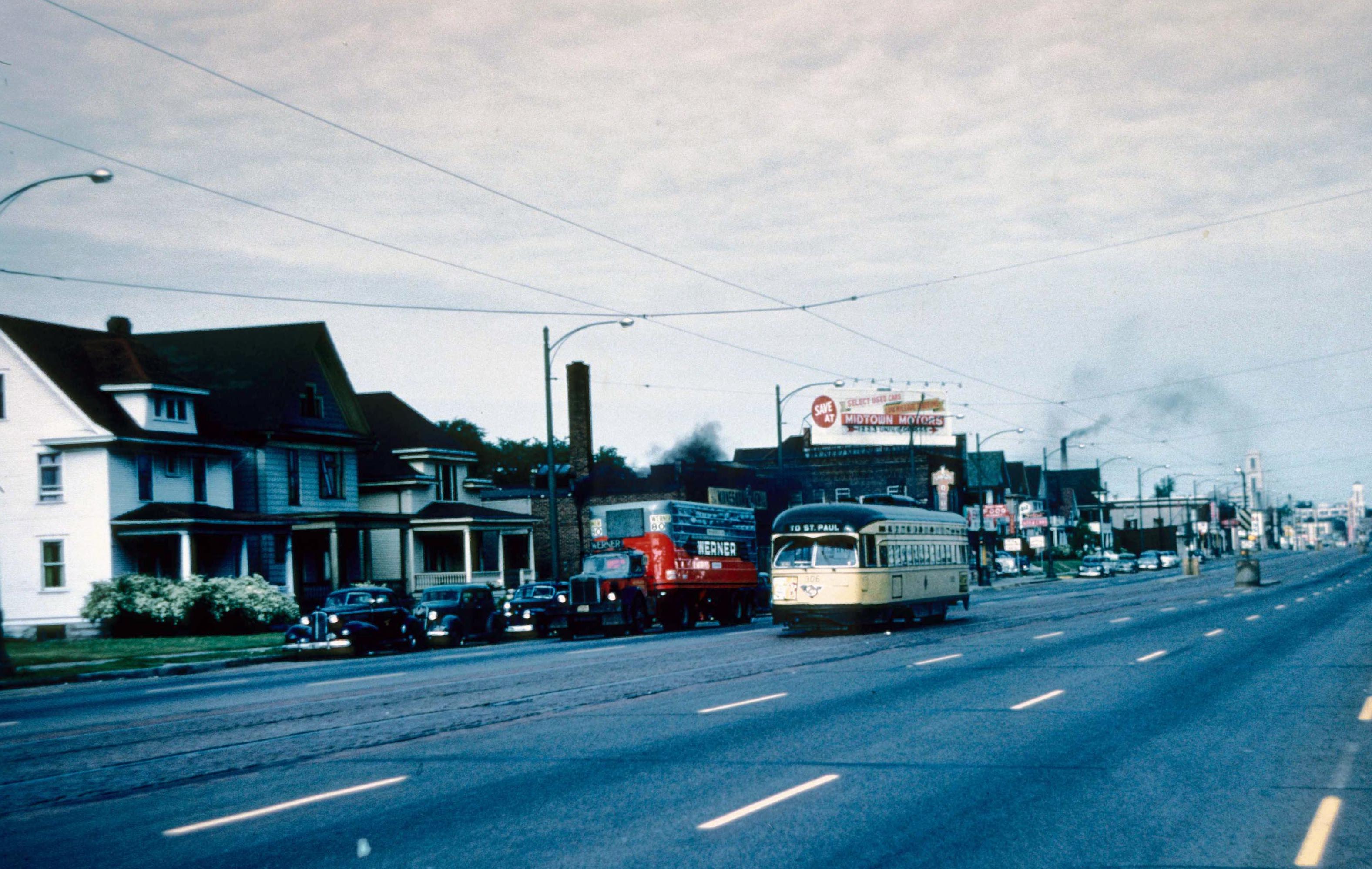 + Dec. 9, 1890 – The first Interurban electric streetcar line begins service between downtown Minneapolis and St. Paul.
+ Dec. 9, 1890 – The first Interurban electric streetcar line begins service between downtown Minneapolis and St. Paul.
+ Aug. 1, 1891 – Interurban streetcars are equipped with mailboxes, allowing residents to deposit mail without boarding. The postal service continues until 1910.
+ Oct. 31, 1953 – Interurban streetcar service ends in St. Paul.
+ Nov. 28, 1953 – Interurban service ends in Minneapolis. Non-revenue trips continue to Snelling Avenue through June 1954, when streetcars disappear entirely from the Twin Cities.
+ June 15, 1998 – Limited-stop bus service 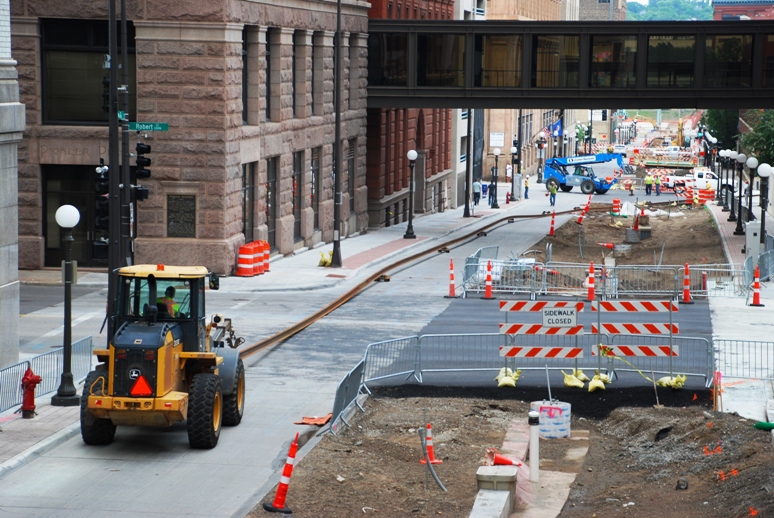 returns to University Avenue with the introduction of Route 50.
returns to University Avenue with the introduction of Route 50.
+ June 28, 2006 – The Metropolitan Council selects light-rail on University Avenue as the “Locally Preferred Alternative” for the Central Corridor following several years of study and public input.
+ Dec. 14, 2006 – The Federal Transit Administration gives approval to begin preliminary engineering on the Central Corridor.
+ Sept. 7, 2010 – Heavy construction begins on Robert Street between University Avenue and 12th Street.
+ April 26, 2011 – A full-funding grant agreement is signed, committing $478  million in federal funding for light-rail construction.
million in federal funding for light-rail construction.
+ July 14, 2011 – First rail line is delivered and placed on Robert Street.
+ May 14, 2012 – Light-rail construction reaches the halfway mark, on schedule.
+ Sept. 5, 2012 – METRO Green Line tracks are welded together with Blue Line tracks between the Metrodome and Cedar-Riverside stations.
+ Oct. 10, 2012 – The first light-rail vehicle built for service on the Green Line debuts in Minneapolis.
+ Dec. 7, 2012 – The restored Union Depot re-opens in Lowertown St. Paul. A light-rail station north of the restored 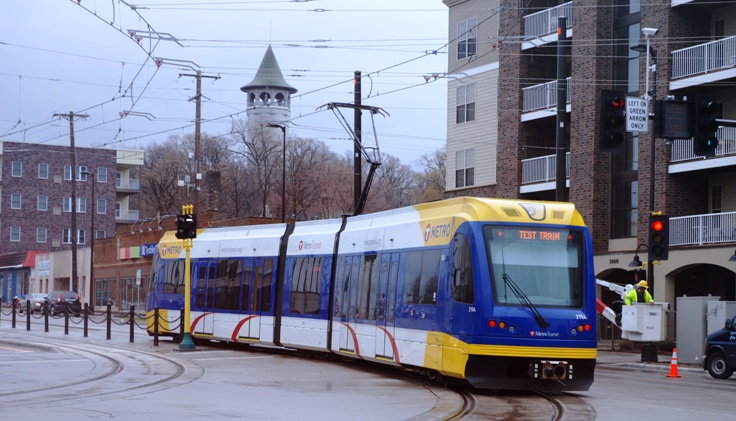 passenger rail building will serve as the Green Line's eastern terminus.
passenger rail building will serve as the Green Line's eastern terminus.
+ July 25, 2013 – The first light-rail vehicle to operate under its own power on Green Line tracks makes its inaugural run.
+ May 17, 2014 – Target Field Station opens in Minneapolis, providing another light-rail platform and public space at the Green Line's western terminus.
+ June 14, 2014 – The METRO Green Line opens for revenue service with celebrations at nine stations and free bus and train rides throughout the weekend.
> MPR: Everything old is new again: Trolley motorman rides the new light rail line
> MinnPost: A timeline of the Green Line
> Pioneer Press: St. Paul’s light rail evokes city’s bygone streetcar era
> The Line: Beyond the Rails: Mapping the development, cultural and community impact of the new Green Line
> Route 50: Limited stops for longer rides
> Route 16: The original Minneapolis-St. Paul connection
> Green Line Project Timeline
> Minnesota Streetcar Museum
Photos: Top Right: Isaacs at the Green Line's Raymond Avenue Station, near one of the original streetcar buildings; middle left: construction workers install embedded tracks at Union Depot Station in St. Paul, courtesy Steve Glischinski, TRAINS Magazine; below right: an Interurban streetcar on University Avenue circa 1950, looking west from Chatsworth Street; Blue and Green line tracks welded together in Minneapolis; Green Line test train in Prospect Park.